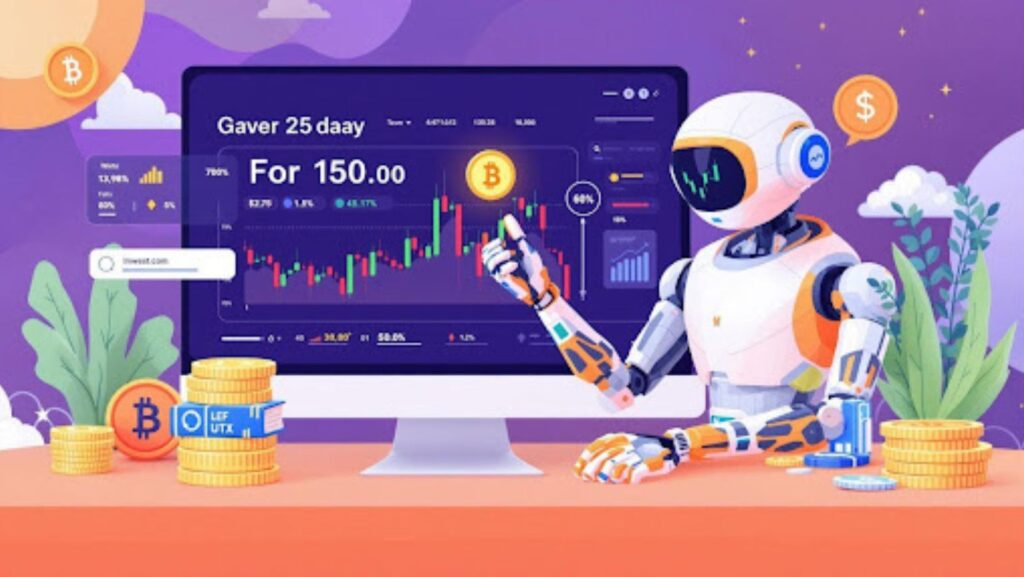The cryptocurrency market operates 24/7, processing over $50 billion in daily trading volume. AI trading bot now handle approximately 80% of high-frequency crypto trades, executing millions of orders daily with microsecond precision. These automated systems help investors manage portfolios ranging from $1,000 to over $1 million, reducing emotional trading decisions and human errors. Leading exchanges report that 70% of their trading volume comes from AI trading bot operations, highlighting their growing role in modern crypto trading.
Understanding AI trading bots basics
At their core, AI trading bots are automated programs that analyze market data and execute trades based on predefined rules and strategies. Think of them as your personal trading assistant that never sleeps, constantly watching the markets and making decisions based on the parameters you set.
“The key advantage of AI trading bots lies in their ability to process vast amounts of data and execute trades faster than any human could, while remaining strictly logical in their decision-making process.”
What are AI trading bots
Trading bots connect directly to cryptocurrency exchanges through API keys – special access codes that allow the bot to place trades on your behalf. They analyze both historical and real-time market data to identify potential trading opportunities according to your chosen strategy.
When using a trading bot, you maintain control over your funds while the bot handles the execution of your trading strategy. The bot operates within strict parameters that you define, including investment amounts, acceptable risk levels, and specific cryptocurrencies to trade. This automation helps remove emotional bias from trading decisions while ensuring your strategy is consistently executed according to plan.
Types of AI trading bots
Different trading goals require different types of bots. Grid trading bots create a grid of buy and sell orders at various price levels. They aim to profit from normal market volatility by buying low and selling high within your specified price range. This strategy works well in sideways markets where prices fluctuate within a predictable range.
Dollar-Cost Averaging (DCA) bots automatically invest fixed amounts at regular intervals. This reduces the impact of market volatility on your overall investment. For example, you might set the bot to buy $100 worth of Bitcoin every week, regardless of the current price.
Arbitrage bots monitor price differences across multiple exchanges. When they detect that an asset is cheaper on one exchange and more expensive on another, they automatically execute trades to profit from the difference.
Portfolio management bots help maintain your desired asset allocation. If you want to keep 50% of your portfolio in Bitcoin and 50% in Ethereum, the bot will automatically rebalance when these percentages drift from your targets.
Market making bots place both buy and sell orders simultaneously, aiming to profit from the spread between prices. This strategy requires more sophisticated understanding and typically larger capital investments.
Essential factors for selection
Trading goals alignment
Before selecting a bot, clearly define your investment objectives. Consider whether you’re looking for short-term gains or long-term investment growth, and how much risk you’re willing to accept. Your trading frequency preferences and capital allocation plans will also influence your choice of bot.
Key requirements for successful bot trading:
- Understanding of market cycles and trends
- Clear risk management strategy
- Sufficient starting capital
- Time for strategy monitoring and adjustment
- Basic technical analysis knowledge
Technical requirements
The technical aspects of a trading bot are crucial for its successful operation. Exchange compatibility should be your first consideration – ensure the bot works with your preferred cryptocurrency exchanges. Remember that some exchanges restrict bot trading entirely.
Cost considerations
The financial aspects of choosing a trading bot extend far beyond the initial purchase or subscription price. Monthly subscription fees typically range from basic plans around $20 to premium offerings exceeding $200.

Trading fees can accumulate quickly, especially with high-frequency trading strategies. Additionally, consider costs for server hosting, data feeds, and potential strategy marketplace purchases.
Security measures
In the cryptocurrency space, security is paramount. Professional-grade trading bots implement multiple layers of protection, including encrypted communication channels and secure API key storage. Advanced platforms allow for granular control over bot permissions, ideally supporting read-only access for market data and limited trading permissions that prevent withdrawals.
User experience
The platform’s user interface plays a crucial role in your trading success. Even experienced traders benefit from clear, intuitive dashboards that display essential information without unnecessary complexity. Quality platforms provide comprehensive documentation, responsive customer support, and educational resources to help users maximize their trading effectiveness.
Common mistakes to avoid
The excitement of automated trading sometimes leads investors to overlook critical considerations. Many traders rush into bot trading without proper research or testing, which can result in significant losses. Another common error involves enabling too many trading pairs simultaneously before fully understanding the bot’s behavior.
Critical mistakes that can damage your trading performance:
- Overcomplicating initial strategies with multiple pairs and conditions
- Ignoring market conditions when selecting strategies
- Using excessive leverage without proper testing
- Missing contingency plans for technical failures
- Choosing bots based solely on advertised profit rates
Making the final decision
The selection process should include a thorough evaluation period using demo accounts or paper trading features. Start with small amounts of capital when transitioning to live trading, gradually increasing your investment as you verify the bot’s performance meets your expectations.
Regular performance reviews become essential once you’ve implemented your chosen bot. Successful traders typically maintain detailed records of their bot’s performance, analyzing metrics such as win rate, average profit per trade, and maximum drawdown periods.
Strategy customization
Professional traders recognize that market conditions constantly evolve, making strategy customization capabilities essential. A robust trading bot should offer comprehensive backtesting features, allowing you to verify your strategy’s effectiveness against historical market data. During high volatility periods, you might need to adjust grid spacing in a grid trading strategy or modify stop-loss levels across multiple trading pairs.
Performance metrics to monitor:
- Risk-adjusted return ratio showing risk-reward balance
- Maximum drawdown and recovery patterns
- Trade efficiency indicators
- Win-rate across different market conditions
- Position sizing effectiveness
Conclusion
Selecting the right AI trading bot requires careful consideration of multiple factors, from technical capabilities to security features and cost structures. Success depends not just on the tool itself but on your understanding of its capabilities and limitations.

No bot guarantees profits – these are tools designed to execute your trading strategy more efficiently, not magical profit generators. Your success will depend on careful research, proper testing, and ongoing strategy refinement.


